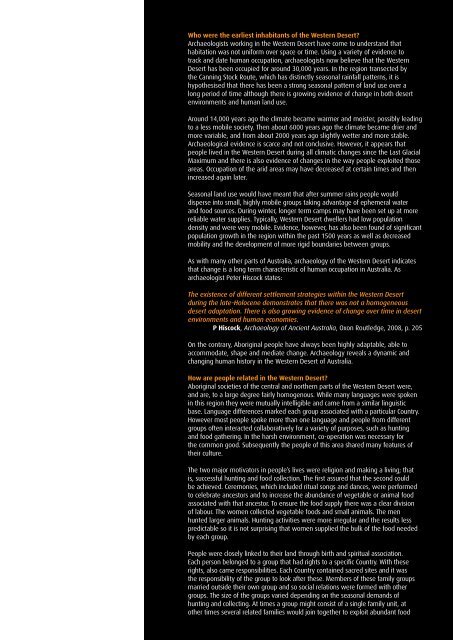Yiwarra Kuju: The Canning Stock Route â education kit - National ...
Yiwarra Kuju: The Canning Stock Route â education kit - National ...
Yiwarra Kuju: The Canning Stock Route â education kit - National ...
- No tags were found...
You also want an ePaper? Increase the reach of your titles
YUMPU automatically turns print PDFs into web optimized ePapers that Google loves.
5<strong>The</strong> story of Rover ThomasRover Thomas is one of Australia’s most prominent artists and pioneered the EastKimberley school of ochre painting on canvas. Although he is not known principallyas a Western Desert artist, his life is closely linked with the stock route.5<strong>Canning</strong> <strong>Stock</strong> <strong>Route</strong>, 1989,by Rover Thomas,Holmes á Court CollectionRover was born in 1926 at Yalta, a soak just north of Well 33 (Kunawarritji). Hisparents died when he was about 10 years old, and drover Wally Dowling foundRover at Kunawarritji and took him north to Billiluna station. His brother had beenaway when their parents died. His nephew remembers:[My father] went looking for his young brother Rover … but nothing, empty. Notrack. Only track was wagon wheel and yawarta [horse] and bullock, that’s all.Clifford Brooks, 1986Rover Thomas grew up with relatives, learning traditional Aboriginal skills as wellas eventually becoming a stockman himself. He began his artistic career as anadult living at Warmun (Turkey Creek). He composed a song cycle which eventuallyled him to want to also paint his stories. This started him on the path to being oneof Australia’s leading artists. He was finally reunited with his brother in the 1980s,a lifetime later, after family recognised the artist’s face in a newspaper.You have got to come back to your Country. You should have come throughthe <strong>Canning</strong> <strong>Stock</strong> <strong>Route</strong>; you went away from here through the stock route andyou should have come back through the stock route. I’ve been waiting for you.Charlie Brooks, Rover’s brother (as recalled by Clifford Brooks), 1986Charlie himself travelled south along the <strong>Canning</strong> to Jigalong mission. A sister,Nyuju Stumpy Brown also followed the drovers out of the desert. She travelledwith her uncle Jamili, a stockman, to Balgo mission. Later Nyuju moved toFitzroy Crossing where she too became an artist. Another sister, Kupi, travelledto La Grange mission (Bidyadanga) with her daughter Mary Meribida who isalso represented in this exhibition. In this family alone, four different schools ofcontemporary painting are represented.6In 2007 Clifford travelled the entire <strong>Canning</strong> <strong>Stock</strong> <strong>Route</strong>, retracing the journey ofRover Thomas. Clifford paints his parents’ Country along the middle stretches of thestock route, including the story of Rover leaving the Country, and his father’s searchfor his brother. He paints in ochres, following Rover’s artistic practice and that ofthe East Kimberley movement he pioneered.6<strong>Canning</strong> <strong>Stock</strong> <strong>Route</strong> Country,2007, by Clifford Brooks,Birriliburu Artists, Tjukurba Gallery,<strong>National</strong> Museum of AustraliaBecause so many Aboriginal people were engaged in droving work betweenWiluna and Halls Creek, a major result of the stock route was to fosteropportunities for making new family connections.<strong>The</strong> story of Billy Patch or ‘Mr P’ who said of himself, I’m just a stock route baby …demonstrates how the stock route facilitated the growth of family connectionsbetween people living along its length. Mr P’s mother was crippled and unableto carry him. Following the Aboriginal tradition that everybody in the group isresponsible for caring for the children, many people cared for him. One of hisuncles, a drover from Fitzroy Crossing, picked him up as a young child and tookhim to live in Wiluna where he eventually settled down and had a family of hisown. For Aboriginal people who live around it, the <strong>Canning</strong> <strong>Stock</strong> <strong>Route</strong> was muchmore than a line of wells to service cattle.(front image) <strong>Canning</strong> <strong>Stock</strong> <strong>Route</strong>,2008, by Mervyn Street, MangkajaArts, <strong>National</strong> Museum of AustraliaNearly all the artists in this exhibition are related one way or another. <strong>The</strong> <strong>Canning</strong><strong>Stock</strong> <strong>Route</strong> story is of people, movement, stories and art tied together by Country.In this story, droving, the principal reason for the construction of the route, is arather insignificant background which can be used to bring into focus theAboriginal story of contemporary desert life.Questions and activities to share with your students1. On a map of the region, trace the journeys of Rover Thomas, Charlie Brooks,Mary Meribida and Nyuju Stumpy Brown as they travelled out of the desertwith the drovers. How far did they travel and how far away were they fromeach other?2. Aboriginal stockmen and women were paid mostly in rations for the timethe <strong>Canning</strong> <strong>Stock</strong> <strong>Route</strong> was in use. What improvements in Aboriginalrights occurred after 1965 that led to equal wages for Aboriginal stockmen?3. Find out about cattle droving. What were the duties of a stockman?4. What effect did droving have on the Aboriginal people? Explain your answer.5. Research the artists in Rover Thomas’s family. Find out about their paintingsand the four different schools of contemporary painting they represent.
















